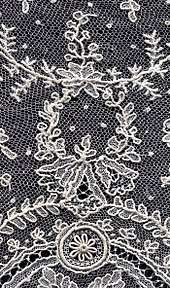Needle lace


Needle lace (also known as needlelace or needle-made lace or point lace) is a type of lace created using a needle and thread to stitch up hundreds of small stitches to form the lace itself.
In its purest form the only equipment and materials used are a needle, thread and scissors. This form of lace making originated in Armenia where there is evidence of an Armenian needle lace making tradition dating back to the pre-Christian era. Turkish needle lace is also very popular around the world. This form however arose separately from what is usually termed needle lace and is generally referred to as knotted lace. Such lace is very durable and will not unravel if one or more loops are broken.
Beginning in the 17th century in Italy, a variety of styles developed where the work is started by securing heavier guiding threads onto a stiff background (such as thick paper) with stitches that can later be removed. The work is then built up using a variety of stitches—the most basic being a variety of buttonhole or blanket stitch. When the entire area is covered with the stitching, the stay-stitches are released and the lace comes away from the paper. See reticella.
Needle lace is also used to create the fillings or insertions in cutwork.
References
- "Structures of Antique Lace". A Collection of Antique Laces. Retrieved July 26, 2005.
External links
-
 Media related to Needle lace at Wikimedia Commons
Media related to Needle lace at Wikimedia Commons - Kenmare Lace And other forms of Irish Lace
- Needlelace - Lace Identification and Types
- Old Point Lace: How to Copy and Imitate It (1878) by Daisy Waterhouse Hawkins. Chatto and Windus, London.
